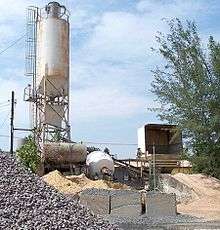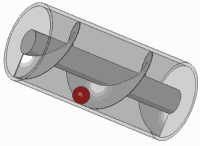Ready-mix concrete



Ready-mix concrete is concrete that is manufactured in a batch plant, according to a set engineered mix design. Ready-mix concrete is normally delivered in two ways.
First is the barrel truck or in–transit mixers. This type of truck delivers concrete in a plastic state to the site.
Second is the volumetric concrete mixer. This delivers the ready mix in a dry state and then mixes the concrete on site.
Batch plants combine a precise amount of rock, sand, water and cement together by weight, allowing specialty concrete mixtures to be developed and implemented on construction sites. The first ready-mix factory was built in the 1930s, but the industry did not begin to expand significantly until the 1960s, and it has continued to grow since then.
Ready-mix concrete is often preferred over other materials due to the cost and wide range of uses, from bird baths to high rise buildings and bridges. It has a long life span when compared to other products of a similar use, like road ways. It has an average life span of 30 years under high traffic areas compared to the 10 to 12 year life of asphalt concrete with the same traffic.
Ready-mix concrete, or RMC as it's also known, refers to concrete that is specifically batched or manufactured for customers' construction projects. It is a mixture of Portland cement, water and aggregates: sand, gravel, or crushed stone. All aggregates should be of a washed type material with limited amounts of fines or dirt and clay. Ready-mix concrete is bought and sold by volume - usually expressed in cubic meters (cubic yards in the US).
Ready-mix concrete is batched or manufactured under controlled conditions. It can be transported and placed at site using a number of methods. In 2011, there were 2,223 companies employing 72,924 workers that produced RMC in the United States.[1]
Advantages and disadvantages of ready-mix concrete
- Materials are combined in a batch plant, and the hydration process begins at the moment water meets the Portland cement, so the travel time from the plant to the site is critical over longer distances. Some sites are just too far away; however, the use of admixtures, retarders and fly ash can be added to slow the hydration process, allowing for longer transit time.[2]
- Cracking and shrinkage. Concrete shrinks as it cures. It can shrink 1/16 inch (1.59mm) over a 10 foot long area (3.05 meters). This causes stress internally on the concrete and must be accounted for by the engineers and finishers placing the concrete.
- Furthermore, access roads and site access have to be able to carry the greater weight of the ready-mix truck plus load. (Green concrete is approx. 3924 pounds per cubic yard.) This problem can be overcome by utilizing so-called "mini mix" trucks which use smaller 4m³ capacity mixers able to reach more weight restricted sites.
- Concrete has a limited lifespan between batching / mixing and curing. This means that ready-mix should be placed within 30 to 45 minutes of batching process to hold slump and mix design specifications.[3] Modern admixtures and plasticizer and water reducers can modify that time span. However, it is limited in scope. The amount and type of admixture added to the mix is very important.
Metered concrete
As an alternative to centralized batch plant system is the volumetric mobile mixer. This is often referred to as on-site concrete, site mixed concrete or mobile mix concrete. This is a mobile miniaturized version of the large stationary batch plant. They are used to provide ready mix concrete utilizing a continuous batching process or metered concrete system. The volumetric mobile mixer is a truck that holds sand, rock, cement, water, fiber, and some add mixtures and color depending on how the batch plant is outfitted. These trucks mix or batch the ready mix on the job site itself. This type of truck can mix as much or as little amount of concrete as needed. The on-site mixing eliminates the travel time hydration that can cause the transit mixed concrete to become unusable, These trucks are just as precise as the centralized batch plant system, since the trucks are scaled and tested using the same ASTM (American standard test method)[4] like all other ready mix manufactures. This is a hybrid approach between centralized batch plants and traditional on-site mixing.[5] Each type of system has advantages and disadvantages, depending on the location, size of the job, and mix design set forth by the engineer.
Transit mixed ready mix vs. volumetric mixed ready mix.
- A centralized concrete batching plant can serve a wide area. Site-mix trucks can serve an even larger area including remote locations that standard trucks cannot.
- The batch plants are located in areas zoned for industrial use, while the delivery trucks can service residential districts or inner cities. Site-mix trucks have the same capabilities.
- Volumetric trucks often have a lower water demand during the batching process. This will produce a concrete that can be significantly stronger in compressive strength compared to the centralized batch plant for the same mix design using the ASTM C109 test method.
- Centralized batch systems are limited by the size of the fleet. It may take upwards of 10 minutes to batch and load out one 9 - 12 yard truck depending on the plant size and type. They are unable to change mix designs during the batch process.
- Volumetric mixers can seamlessly change all aspects of the mix design while still producing concrete. They can continuously mix quality concrete for an indefinite time while being continuously loaded with fresh materials. They can produce 1 yard of concrete in as little as 40 seconds depending on the mix design and batch plant size outfitted.
- For short loads, (orders under 10 yards) Transit Mixers typically return to their batch plant after each delivery. Volumetric trucks can go directly from job to job until a truck is emptied, reducing traffic and fuel consumption.
See also
References
- Notes
- ↑ "Ready Mix Concrete Manufacturer". akonaindia.com.
- ↑ "Chemical Admixtures".
- ↑ ASTM C 94 and AASHTO M 157
- ↑ ASTM (American standard test method)
- ↑ Casey, Jon M. "Parmer Metered Concrete offers precision and quality". Hard Hat News. Retrieved 24 November 2014.
- Bibliography
- Panarese, William C.; Kosmatka, Steven H.; Kerkhoff, Beatrix (2002). "10". Design and Control of Concrete Mixtures. Skokie, Illinois: Portland Cement Association. ISBN 0-89312-217-3.